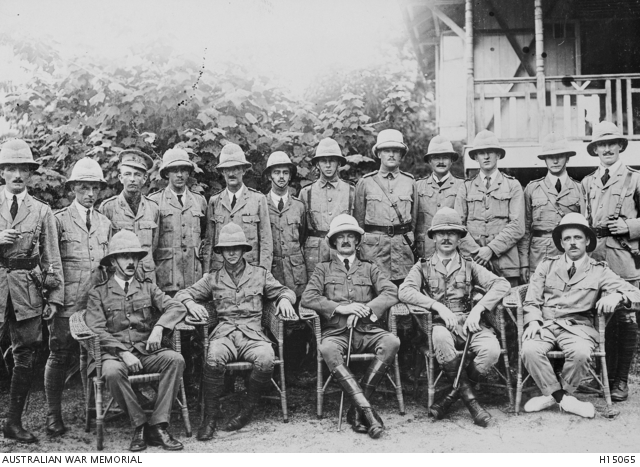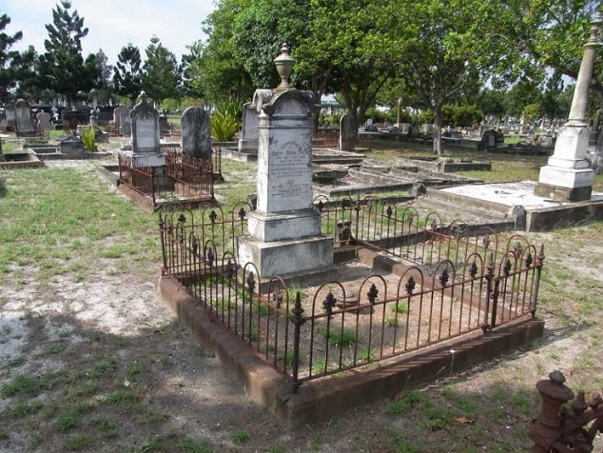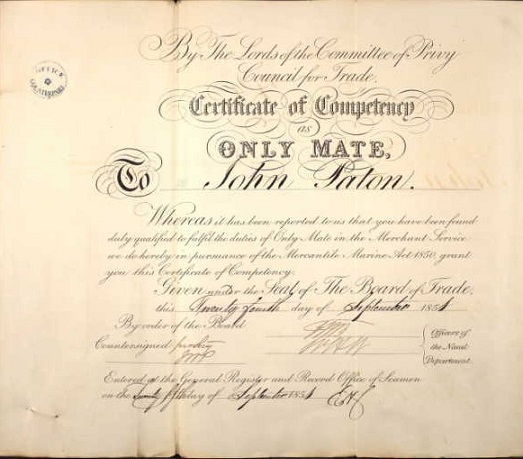Military Commanders
Temporary Brigadier General: John Gibson PATON. CB CMG VD
Born: 18th November 1867. Newcastle, New South Wales, Australia.
Married: 19th April 1897. Armidale, New South Wales, Australia.
Wife: Margaret Mary Paton. nee: Donnelly. (1876-1926)
Died: 21st November 1943. Newcastle, New South Wales, Australia.
Father: Captain: John Paton. (1832-1895)
Mother: Elizabeth Paton. nee: Will. (1848-1937)
INFORMATION
Paton, John (1867–1943)
This article was published in Australian Dictionary of Biography, Volume 11, (MUP), 1988
John Paton (1867-1943), merchant and soldier, was born on 18 November 1867 at Newcastle, New South Wales, son of John Paton, master mariner, and his wife Elizabeth, née Will(?), both born at Dundee, Scotland. He was educated in Newcastle and went into business, becoming chief accountant and then managing director of R. Hall & Son Pty Ltd, import merchants, as well as chairman of the Newcastle & Hunter River Steamship Co. and director of the City of Newcastle Gas & Coke Co. Ltd. On 19 April 1897, at Armidale, he married Margaret Mary Donnelly with Catholic rites. He had joined the New South Wales Military Forces (Volunteers) as a second lieutenant in the 4th Infantry Regiment in December 1887, was promoted captain in 1894, major in 1907 and lieutenant-colonel in 1909, and by July 1914 was colonel of the 4th Infantry Brigade. When war came he was given command of Newcastle Defended Port.
Paton wanted to see action, however, and was content to drop rank to lieutenant-colonel to become second-in-command, under Colonel William Holmes, of the Australian Naval and Military Expeditionary Force sent to seize German New Guinea in September 1914. While there he commanded the infantry on an expedition under Lieutenant-Commander J. M. Jackson to capture the German motor yacht Komet. He was credited with boarding it, first, revolver in hand. In December, however, the Australian government sent Colonel (Sir) Samuel Pethebridge, who had been permanent head of the Department of Defence, as administrator to New Guinea and tension developed between his team and the military force. When reports of looting occurred, Pethebridge ordered a search of the baggage of all officers and men departing for Australia. This led to a court of inquiry in Australia and courts-martial for various officers, including Paton, who had in his possession silver 'souvenirs' from the Komet and was in effect charged with looting. He may also have used his warehouse facilities at Newcastle to store goods for other members. The army's honour was at stake and Paton and the other officers were acquitted—which led to an outcry in the press and Federal parliament, where Frank Anstey described the trials as a 'farce'.
Paton, meanwhile, had enlisted in the Australian Imperial Force on 16 March 1915 as lieutenant-colonel commanding the 25th Battalion and reached Gallipoli in September. After temporarily commanding the 7th Brigade from 15 October, on 1 January 1916 he was promoted colonel and temporary brigadier general before sailing for France. In November he was wounded by a sniper while standing on the parapet of a trench before the assault on Flers and was evacuated to England. Once recovered, Paton commanded the 17th Brigade there from May to July 1917 when he returned to take over the 6th Brigade in Belgium and France, leading it in the attacks on Broodseinde, Passchendaele and Ville-sur-Ancre. He was twice temporarily in command of the 2nd Division.
On 24 August 1918 he returned to Australia. His health after his wound had been poor and he seems to have been tiring and not driving his battalion commanders effectively. The creation of the Australian Corps under Sir John Monash led to the appointment of (Sir) Charles Rosenthal as divisional commander and Paton showed some pique at juniors being promoted over him. He stayed on for the early July battle of Hamel but was induced to retire soon after. For his war service he was appointed C.B. (1916) and C.M.G. (1918) and was mentioned in dispatches three times and awarded the Order of St Stanislaus (Russia).
Back in Australia, Paton took up again his management of R. Hall & Son, and became president of the Newcastle Chamber of Commerce (1920-23) and vice-president (1919-20, 1929-31). He was also local president of the Boy Scouts' Association for some years, first president of Newcastle Rotary Club and closely connected with the Returned Sailors' and Soldiers' Imperial League of Australia. He also continued his part-time connexion with the army, being temporarily in command of the 5th and 1st Infantry Brigades, Australian Military Forces, and then the 2nd Division, finally retiring in 1926 with the honorary rank of major general. Survived by one son, Paton died on 21 November 1943 at Newcastle and was cremated with Presbyterian forms. His estate was sworn for probate at £27,371.
Select Bibliography
- C. E. W. Bean, The Story of Anzac (Syd, 1921, 1924)
- S. S. Mackenzie, The Australians at Rabaul (Syd, 1927)
- C. E. W. Bean, The A.I.F. in France, 1917-18 (Syd, 1933, 1937, 1942)
- Parliamentary Debates (Commonwealth), 1914-17, p 2530, 3480
- Newcastle Morning Herald, 13 May 1915, 22 Nov 1943
- Proceedings of the Court Martial of Colonel J. Paton (A471, item 222, National Archives of Australia)
- Monash to Birdwood, 7 June 1918, in John Monash papers (National Library of Australia).

Outdoor group portrait of officers of the Rabaul Garrison of the Australian Naval and Military Expeditionary Force.
All except two went on to serve overseas with the AIF. Identified from left to right, back row: Lieutenant (Lt) Harold Woodford Johnson (later promoted Major and awarded Military Cross); Lt John Malbon Maughan (later promoted Major and awarded Distinguished Service Order); Lt Ivan Brunker Sherbon (later promoted Captain, awarded Military Cross, killed in action in France on 14 November 1916); Lt Victor Horatio Buller Sampson (later promoted Major and killed in action in France on 19 July 1916); Lt John Ellesmere Westgarth (later promoted Major in the Light Horse); Lt Patrick Kendall Barton Quinn (served as Lieutenant in 35th Battalion); Lt Alan Forbes Anderson (later promoted Major and Mentioned in Despatches); Lt John Ambrose McDowell (later promoted Major and Mentioned in Despatches); Lt Robert Partridge (appointment terminated 4 March 1915); Lt Rupert Markham Sadler (later promoted Lieutenant Colonel, awarded Military Cross, Distinguished Service Order, Mentioned in Despatches, also served in the Second World War); Lt Herbert Leslie Bruce (later promoted Major and awarded Military Cross); and Lt William Charles Meredith Penly (later Lieutenant in 55th Battalion). Front row: Lt Lionel Babington Ravencroft; Major Alexander Windeyer Ralston (later promoted Lieutenant Colonel, awarded Distinguished Service Order, Companion of the Order of St Michael and St George and Mentioned in Despatches on three occasions); Lieutenant Colonel John Paton (later Temporary Brigadier General and awarded Order of St Stanislas - 2nd Class (with swords) (Russia) and Mentioned in Despatches on two occasions); Captain (Capt) Sydney Percival Goodsell (later promoted Major and awarded Croix de Guerre (France) and Mentioned in Despatches); and Capt Charles Edye Manning ( later promoted Major, Mentioned in Despatches and killed in action in France on 7 August 1916).
| Lieutenant Colonel: John Paton | |
| Unit | 25th Australian Infantry Battalion |
|---|---|
| Service | Australian Imperial Force |
| Conflict/Operation | First World War, 1914-1918 |
| Award | Companion of the Order of the Bath |
| Commonwealth of Australia Gazette | 21 September 1916 on page 2621 at position 24 |
| London Gazette | 3 June 1916 on page 5555 at position 1 |
| Temporary Brigadier General: John Paton | |
| Unit | Staff |
|---|---|
| Service | Australian Imperial Force |
| Conflict/Operation | First World War, 1914-1918 |
| Award | Mention in despatches |
| Commonwealth of Australia Gazette | 30 November 1916 on page 3233 at position 21 |
| London Gazette | 13 July 1916 on page 6943 at position 6 |
| Temporary Brigadier General: John Paton | |
| Unit | 7th Australian Infantry Brigade |
|---|---|
| Service | Australian Imperial Force |
| Conflict/Operation | First World War, 1914-1918 |
| Award | Russian Order of St Stanislaus, Second Class |
| Commonwealth of Australia Gazette | 25 July 1917 on page 1542 at position 9 |
| London Gazette | 15 February 1917 on page 1600 at position 3 |
| Temporary Brigadier General: John Paton | |
| Unit | Staff |
|---|---|
| Service | Australian Imperial Force |
| Conflict/Operation | First World War, 1914-1918 |
| Award | Mention in despatches |
| Commonwealth of Australia Gazette | 24 October 1918 on page 2055 at position 59 |
| London Gazette | 28 May 1918 on page 6200 at position 43 |
| Temporary Brigadier General: John Paton | |
| Unit | 5th Australian Infantry Brigade |
|---|---|
| Service | Australian Imperial Force |
| Conflict/Operation | First World War, 1914-1918 |
| Award | Companion of the Order of St Michael and St George |
| Commonwealth of Australia Gazette | 7 November 1918 on page 2110 at position 16 |
| London Gazette | 3 June 1918 on page 6454 at position 12 |
Family Information
John Paton was a member of the Newcastle Club upon his enlistment with the AIF.


John's father Berthing Master; Captain John Paton (1832-1895) Sandgate Cemetery

Under Construction: 09/12/2020.
